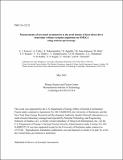Measurements of low-mode asymmetries in the areal density of laser-direct-drive deuterium–tritium cryogenic implosions on OMEGA using neutron spectroscopy
Author(s)
Forrest, C.J.; Crilly, A.; Schwemmlein, A.; Appelbe, B.; Gatu Johnson, Maria; Betti, R.; Knauer, J.P.; Glebov, V. Yu.; Gopalaswamy, V.; Mannion, O.M.; Mohamed, Z.L.; Radha, P.B.; Regan, S.P.; Stoeckl, C.; Theobald, W.; ... Show more Show less
Download22ja022_full.pdf (1.899Mb)
Metadata
Show full item recordAbstract
Areal density is one of the key parameters that determines the confinement time in inertial confinement fusion experiments, and low-mode asymmetries in the compressed fuel are detrimental to the implosion performance. The energy spectra from the scattering of the primary deuterium–tritium (DT) neutrons off the compressed cold fuel assembly are used to investigate low-mode nonuniformities in direct-drive cryogenic DT implosions at the Omega Laser Facility. For spherically symmetric implosions, the shape of the energy spectrum is primarily determined by the elastic and inelastic scattering cross sections for both neutron-deuterium and neutron-tritium kinematic interactions. Two highly collimated lines of sight, which are positioned at nearly orthogonal locations around the OMEGA target chamber, record the neutron time-of-flight signal in the current mode. An evolutionary algorithm is being used to extract a model-independent energy spectrum of the scattered neutrons from the experimental neutron time-of-flight data and is used to infer the modal spatial variations (l = 1) in the areal density. Experimental observations of the low-mode variations of the cold-fuel assembly (ρL0 + ρL1) show good agreement with a recently developed model, indicating a departure from the spherical symmetry of the compressed DT fuel assembly. Another key signature that has been observed in the presence of a low-mode variation is the broadening of the kinematic end-point due to the anisotropy of the dense fuel conditions.
Description
Submitted for publication in Review of Scientific Instruments
Date issued
2022-05Department
Massachusetts Institute of Technology. Plasma Science and Fusion CenterJournal
Review of Scientific Instruments
Publisher
AIP
Other identifiers
22ja022